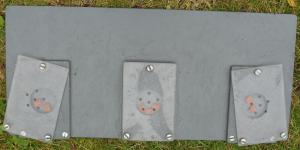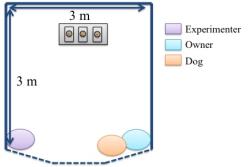Animals
The dogs participating in the study were recruited through announcement in the social media and from previous studies. It included a total of 66 dogs: 36 German Shepherds and 30 Labradors. The age and sex distribution were uniformly distributed between breeds and the age was normaly distributed.
Location and material
The testing was performed outdoors in the Linköping University campus. As this study was done in parallel to another study on Labrador types conducted in locations all across Sweden, a marquee tent was used as a uniform testing environment. The tent was closed by a small fence to provide a defined testing area.
The behavioural tests were recorded with a video camera for later detailed analysis.
For the pointing test, I used two black buckets, and for the problem solving, a test device (picture below) used in past studies in the research team. This device is formed of PVC and Plexiglas slabs forming three pits where treats are placed. All pits are closed by Plexiglas slabs with holes for olfaction, the side pits can be slid open, the middle one is screwed closed.

Tests

- Problem solving test
In the problem solving test, the dogs were left roaming freely in the tent with the testing device for three minutes.
The owner and the experimenter were present in the tent, each in a corner (see figure) and were to remain neutral and gaze towards the test setup. In case the dog did not access any treat after one minute, the experimenter slid half-open the two accessible pits to keep the dog's interest up.

- Pointing test
The pointing tests started with the dog and the owner standing outside the tent (the owner holding the dog), facing the experimenter (I), who was standing in the back of the tent (see picture). I hid a treat in one of the two buckets while facing backwards, then turned around and put both buckets on the ground on my sides. I established eye contact with the dog before pointing with the whole arm towards the bucket with the treat. Then I returned to a neutral arm position before releasing the dog by saying "varsågod". If needed, the owner repeated the releasing command. The dog could then make its choice between buckets, and as soon as its nose would come a few centimeters away from one bucket, I took away the other one so the dog could only access the bucket he/she first chose.
The pointing test was repeated 20 times with a small break after the first 10 repetitions.
Extra data
As mentioned in the introduction, the hair cortisol was analysed: hair samples were collected after the tests, from the neck area. The cortisol was assessed by methanol extraction coupled with Radioimmunoassay (RIA).
The behavioural questionnaire the owner filled, the Canine Behavioral Assessment and Research Questionnaire (C-BARQ), is a recognized behavioural and temperament questionnaire in behavioural research.
Data extraction & analysis
Most of the data for the problem solving test was extracted with the Noldus software Observer (enabling to extract easily the frequency and duration of each behaviour), with a large ethogram comprised of the communication behaviours (physical and eye contact) but also of the activity, position in the tent, etc.
In the pointing test, I extracted the data for the accuracy of choice (each choice was recorded as correct or wrong), and the latency of choice (between the time the dog was released to the moment of the choice, when the nose was a few centimeters away from a bucket).
The data was statistically tested to reveal variation between breed and sex, and then a correlation analysis was performed across all the parameters.
Responsible for this page:
Director of undergraduate studies Biology
Last updated:
05/03/15
